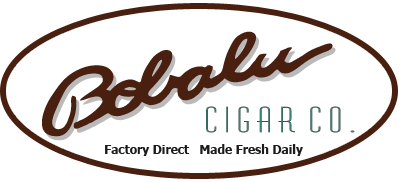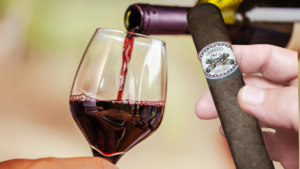Cigar manufacturers employ a wide array of techniques to flavor cigars, each method contributing to the unique taste and aroma of the final product. These methods range from traditional practices to innovative approaches, allowing for a diverse selection of flavored cigars that cater to various preferences.
1. Dipping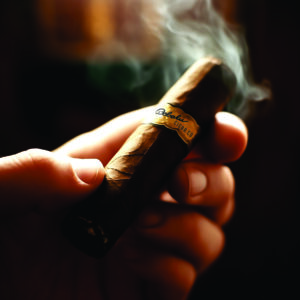
Dipping involves immersing the cigar in a flavored liquid, such as liquor (rum, brandy, or whiskey), flavored syrup, or essential oils. The cigar is carefully dipped to avoid over-saturation, which ensures even burning and a balanced flavor.
2. Injecting
Injecting uses a needle or fine nozzle to introduce a flavored liquid directly into the cigar. This method allows for precise control over the distribution of flavor, targeting specific parts like the filler, binder, or wrapper as needed.
3. Spraying
Spraying entails misting the cigar with a flavored liquid using a spray bottle. This technique provides an even coating of flavor without the risk of over-saturating the cigar, maintaining the tobacco’s integrity.
4. Infusing
Infusing cigars involves placing them in a sealed container with flavored substances such as fruit, herbs, spices, or flavored liquids like spirits. Over time, the cigars absorb the flavors, resulting in a nuanced and well-integrated taste. A common practice is to place a cigar in a humidor with a small glass of the desired spirit, allowing the aroma to permeate the cigars over several weeks.
5. Cask Conditioning
Cask conditioning ages cigars in wooden barrels (casks) that previously held spirits or wines. The cigars absorb flavors from the wood and any residual alcohol, imparting complex, subtle flavors over a prolonged period.
6. Flavoring the Filler
- Pre-Flavored Tobacco Leaves: Individual tobacco leaves used for the filler can be pre-flavored by lightly spraying or brushing them with a flavored solution.
- Blending with Naturally Flavored Leaves: Mixing standard tobacco leaves with naturally flavored or aromatic leaves creates a unique blend that enhances the overall flavor profile.
7. Flavoring the Binder
- Soaking or Spraying: The binder leaf, which holds the filler together, can be soaked or sprayed with a flavoring agent to ensure flavor consistency throughout the cigar.
8. Flavoring the Wrapper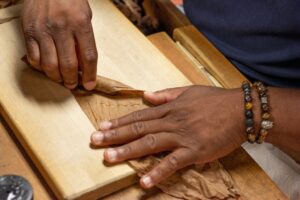
- Coating: The outer wrapper leaf can be lightly coated with a flavored substance using a brush or mist spray, providing an even application.
- Flavor-Infused Wrappers: Wrappers can be infused with flavor during their curing process, allowing them to absorb the essence of the flavor over time.
9. Natural Flavor Incorporation
- Natural Curing: Tobacco can be cured in barns with natural flavoring agents like fruits, vanilla beans, or spices hung alongside. This method allows the tobacco to naturally absorb flavors.
- Flavored Humidifiers: Using flavored humidifiers in storage or aging areas allows cigars to absorb subtle flavors from the surrounding air.
10. Essential Oils
Essential Oils: Applying essential oils derived from herbs, spices, or fruits in small quantities can impart noticeable flavors to cigars. These oils are potent and require careful handling to avoid overpowering the cigar.
11. Humidification with Flavored Water
Humidification with Flavored Water: In the humidification process, using water flavored with natural extracts or essences can subtly impart flavors to cigars over time.
12. Aging with Flavored Wood
Aging Boxes: Some cigars are aged in boxes made from or lined with flavored woods, such as cedar or cherry wood, that have been treated or infused with flavors. The cigars absorb these flavors during the aging period.
13. Artificial Flavor Additives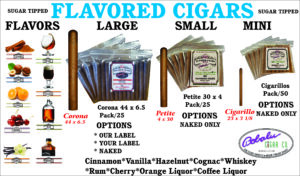
Artificial Flavoring Agents: Although less common among premium cigars, some manufacturers use artificial flavoring agents for consistency and to achieve specific flavors.
14. Combining Multiple Methods
Layered Flavoring Techniques: Combining various methods, such as infusing with a flavored spirit and then aging in a flavored wood cask, can create a more complex and layered flavor profile.
By utilizing these diverse techniques, cigar manufacturers can create a wide range of flavored cigars, ensuring there is something to suit every palate. These methods not only enhance the natural flavors of the tobacco but also offer unique and personalized smoking experiences.
- Natural Curing: Tobacco can be cured in barns with natural flavoring agents like fruits, vanilla beans, or spices hung alongside. This method allows the tobacco to naturally absorb flavors.
- Flavored Humidifiers: Using flavored humidifiers in storage or aging areas allows cigars to absorb subtle flavors from the surrounding air.
10. Essential Oils
Essential Oils: Applying essential oils derived from herbs, spices, or fruits in small quantities can impart noticeable flavors to cigars. These oils are potent and require careful handling to avoid overpowering the cigar.
11. Humidification with Flavored Water
Humidification with Flavored Water: In the humidification process, using water flavored with natural extracts or essences can subtly impart flavors to cigars over time.
12. Aging with Flavored Wood
Aging Boxes: Some cigars are aged in boxes made from or lined with flavored woods, such as cedar or cherry wood, that have been treated or infused with flavors. The cigars absorb these flavors during the aging period.
13. Artificial Flavor Additives
Artificial Flavoring Agents: Although less common among premium cigars, some manufacturers use artificial flavoring agents for consistency and to achieve specific flavors.
14. Combining Multiple Methods
Layered Flavoring Techniques: Combining various methods, such as infusing with a flavored spirit and then aging in a flavored wood cask, can create a more complex and layered flavor profile.
By utilizing these diverse techniques, cigar manufacturers can create a wide range of flavored cigars, ensuring there is something to suit every palate. These methods not only enhance the natural flavors of the tobacco but also offer unique and personalized smoking experiences.
